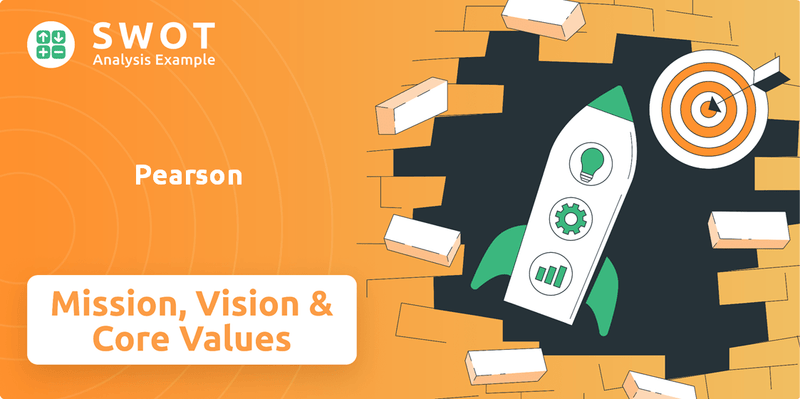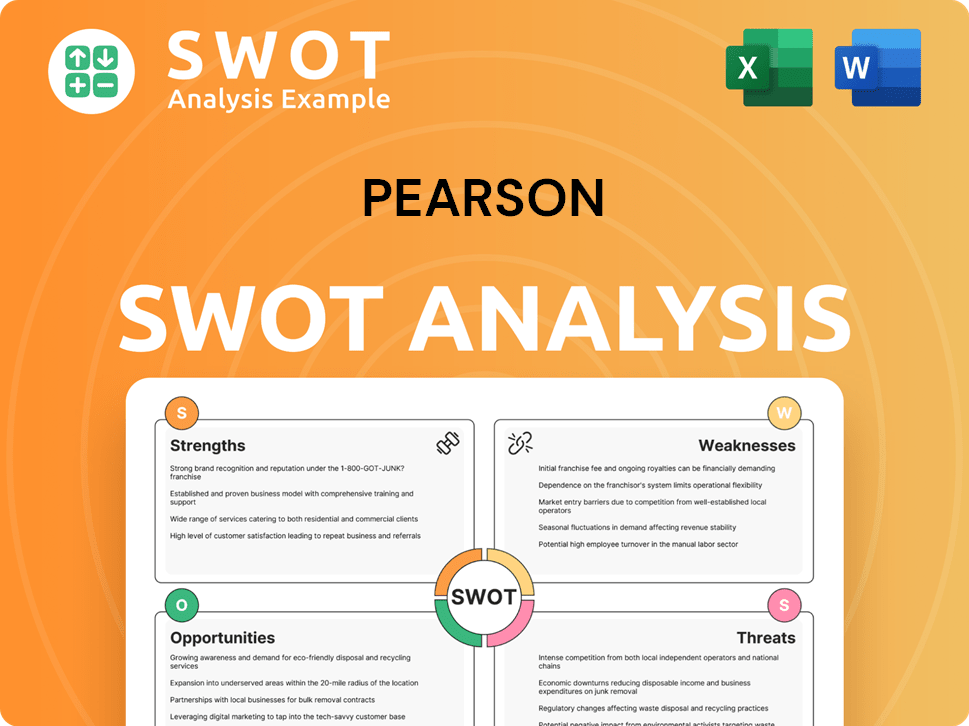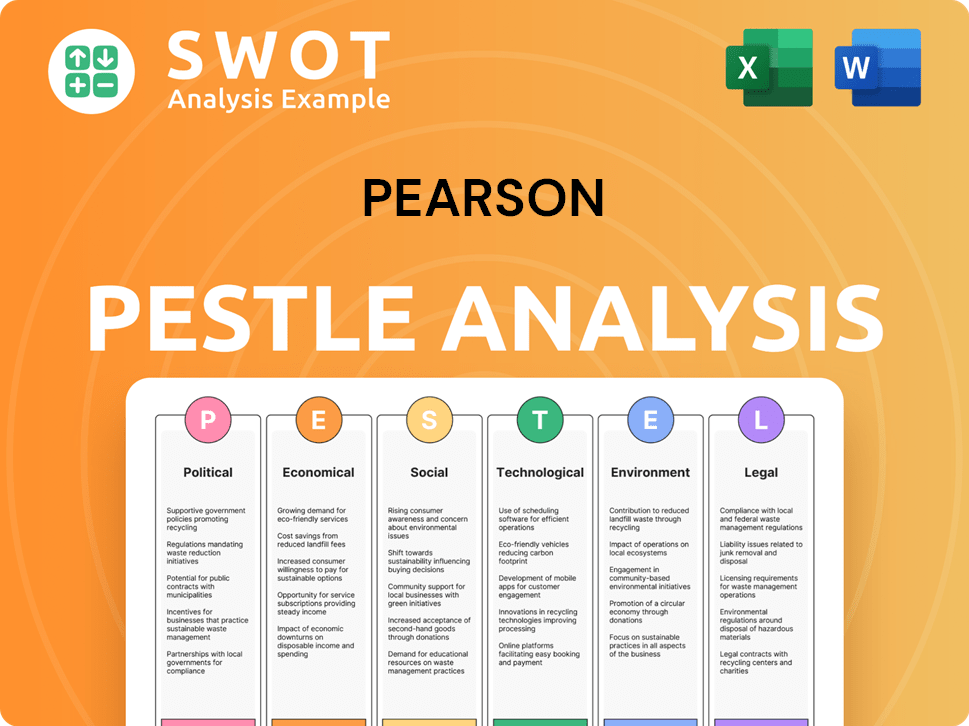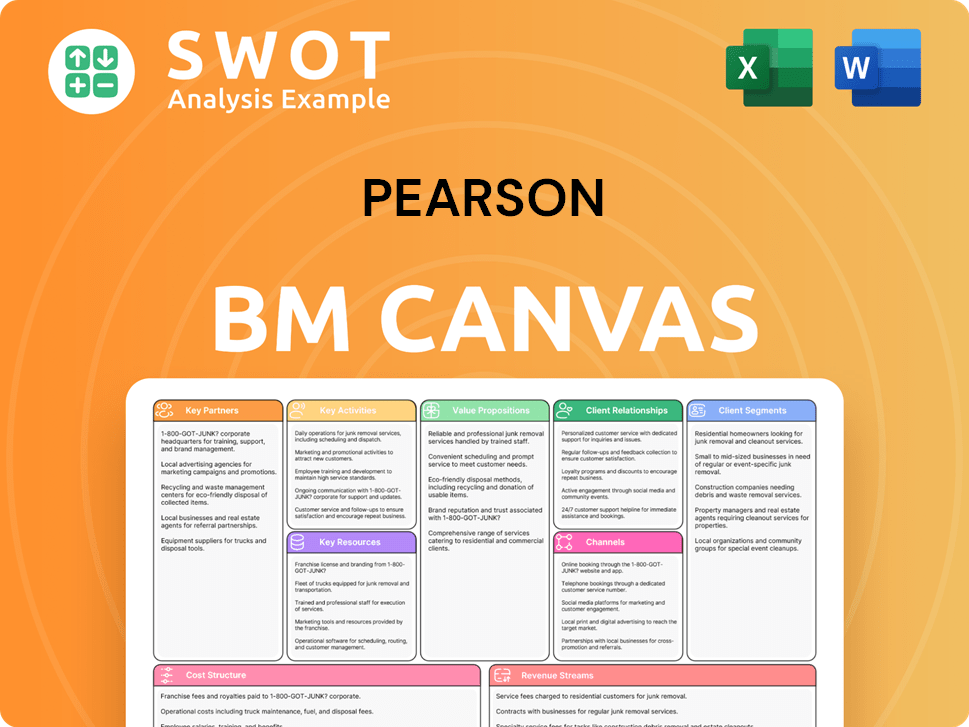Pearson Bundle
What Drives Pearson's Strategy?
Understanding a company's core principles is paramount for any investor or strategist. Pearson, a global leader in education, relies on its mission, vision, and core values to navigate the ever-evolving educational landscape. These statements are the bedrock of their operations and future endeavors.

Delving into Pearson SWOT Analysis can provide a deeper understanding of the company's strategic positioning, but first, let's explore the fundamental pillars that guide Pearson's actions. Examining the Pearson mission, Pearson vision, and Pearson core values offers essential insights into their commitment to Pearson's goals and their impact on global education. Discover how Pearson company defines its core values and supports its mission.
Key Takeaways
- Pearson's mission, vision, and values provide a strong foundation for its strategic direction.
- Customer-centric mission focused on empowering individuals through learning is a key strength.
- Forward-looking vision of lifelong learning with real-life impact is crucial for future success.
- Values emphasizing curiosity, innovation, trust, quality, and impact are central to Pearson's identity.
- Continued alignment with core principles is essential for navigating the evolving educational landscape.
Mission: What is Pearson Mission Statement?
Pearson's mission is 'To help people realise the life they imagine through learning.'
Let's delve into the heart of Pearson's purpose. Understanding the Pearson mission is crucial for grasping the company's direction and its impact on the global education landscape. This mission statement is a concise yet powerful declaration of intent, serving as a guiding light for all of Pearson's activities.
The Pearson mission centers on empowering individuals through learning. It emphasizes the transformative power of education to shape lives. This mission underscores the company's commitment to providing educational resources and services.
The target audience is expansive, encompassing anyone seeking to improve their life through learning. This includes students of all ages, professionals looking to upskill, and lifelong learners. Pearson aims to cater to diverse educational needs globally.
While the mission statement doesn't explicitly list products, they are the vehicles for achieving its goals. Pearson offers a wide range of educational content, assessments, and services. These tools are designed to facilitate learning and personal growth.
Pearson operates on a global scale, positioning itself as the 'world's lifelong learning company.' This global reach allows the company to impact education worldwide. They are constantly adapting to serve diverse markets.
The mission is fundamentally customer-centric, focusing on individual aspirations. This approach ensures that Pearson's offerings are relevant and effective. They prioritize the learner's experience and outcomes.
Innovation is crucial for achieving the Pearson mission. The company continuously develops new learning solutions, particularly digital and AI-enhanced ones. They are investing heavily in technologies like AI to personalize learning experiences.
Pearson's commitment to innovation is evident in its AI-powered tools, such as the Digital Language Tutor and AI-powered instructor tools, which directly support its mission. Furthermore, Pearson's expansion into the Enterprise Learning and Skills market demonstrates its dedication to addressing the skills gap and preparing individuals for the future of work. The company's strategic focus on digital learning solutions aligns with the growing demand for online education, which, according to recent reports, is projected to reach $325 billion by 2025. This commitment to digital transformation and AI integration reflects Pearson's proactive approach to meeting the evolving needs of learners and educators worldwide. For a deeper understanding of Pearson's competitive landscape, you can explore the Competitors Landscape of Pearson.
Pearson SWOT Analysis
- Complete SWOT Breakdown
- Fully Customizable
- Editable in Excel & Word
- Professional Formatting
- Investor-Ready Format

Vision: What is Pearson Vision Statement?
Pearson's vision is 'to add life to a lifetime of learning so everyone can realize the life they imagine.'
The Pearson vision statement is a forward-looking declaration that encapsulates the company's aspirations for the future of education. It moves beyond the present to articulate a desired future state, emphasizing the transformative power of learning. This vision serves as a guiding star, steering the company's strategic decisions and initiatives. Understanding the Pearson vision is crucial for grasping the company's long-term objectives and its commitment to shaping the future of education globally.
The vision highlights lifelong learning as a continuous process, emphasizing that learning extends beyond formal education. It underscores the belief that learning is a fundamental human experience, enriching lives at every stage. This perspective is reflected in Pearson's diverse range of products and services designed for learners of all ages and backgrounds.
Pearson aims to create dynamic and engaging learning experiences. This involves developing innovative educational content and delivery methods, including digital platforms, interactive tools, and personalized learning pathways. The goal is to make learning more accessible, effective, and enjoyable for all learners.
The vision stresses the importance of learning that translates into tangible outcomes in the real world. This means equipping learners with the knowledge, skills, and competencies they need to succeed in their personal and professional lives. Pearson focuses on creating learning experiences that are relevant, practical, and aligned with the demands of the modern world.
Pearson's vision is global in scope, aiming to impact learners worldwide. It also emphasizes inclusivity, striving to make learning accessible to everyone, regardless of their background or circumstances. This commitment is reflected in Pearson's efforts to provide educational resources in multiple languages and formats, catering to diverse learning needs.
Pearson is actively investing in digital transformation, artificial intelligence, and workforce skills development to realize its vision. These strategic initiatives are designed to enhance the learning experience, personalize learning pathways, and prepare learners for the future of work. For example, Pearson's digital sales reached £1.9 billion in 2023, representing 71% of total sales, demonstrating a strong commitment to digital innovation.
The redefinition of Pearson's brand to emphasize lifelong learning reflects a belief in the inherent human capacity for learning. This belief guides the company's approach to product development, partnerships, and overall strategy. Pearson's commitment to this vision is evident in its ongoing efforts to expand its offerings and reach a wider audience.
The Pearson mission and Pearson vision work together to define the company's purpose and aspirations. While the mission outlines what Pearson does, the vision paints a picture of the future it aims to create. This alignment ensures that all of Pearson's activities are geared towards achieving its long-term goals. For further insights into the company's structure and ownership, you can explore resources like Owners & Shareholders of Pearson.
Pearson PESTLE Analysis
- Covers All 6 PESTLE Categories
- No Research Needed – Save Hours of Work
- Built by Experts, Trusted by Consultants
- Instant Download, Ready to Use
- 100% Editable, Fully Customizable

Values: What is Pearson Core Values Statement?
Understanding the core values of a company provides valuable insight into its operational principles and its commitment to its stakeholders. Pearson, a global leader in education, has established a set of core values that guide its actions and shape its identity within the educational landscape.
This value, central to Pearson's mission, emphasizes a culture of inquiry and continuous improvement. It drives the company to constantly seek better ways to understand how people learn, leading to innovative product development and a proactive approach to market changes. For instance, Pearson invests heavily in research and development, allocating approximately $150 million annually to ensure its products and services meet the evolving needs of learners and educators. This commitment is reflected in its development of AI-powered learning tools, which saw a 25% increase in user engagement in the last year.
This value fosters imagination and the exploration of new possibilities within Pearson's vision. It fuels innovation, leading to the creation of new digital tools and learning experiences. Pearson's commitment to this value is evident in its strategic partnerships and investments in emerging technologies, such as virtual reality and augmented reality, aimed at enhancing the learning experience. These initiatives have contributed to a 10% increase in student satisfaction scores across various digital learning platforms.
Integrity and reliability are paramount to Pearson's operations, influencing every aspect from assessments to ethical business practices. This value ensures the creation of high-quality, trustworthy learning materials. Pearson's dedication to earning trust is reflected in its rigorous quality assurance processes, with over 99% of its assessments meeting stringent validity and security standards. Furthermore, Pearson is committed to data privacy, aligning with global regulations like GDPR and CCPA, which is critical in today's data-driven world.
Pearson's commitment to excellence is evident in its rigorously designed educational content and assessments. This value drives a focus on high standards and continuous improvement, ensuring effective and reliable learning experiences. The company's dedication to quality has helped it maintain a strong market position, with its educational materials and assessments used by millions of learners worldwide. Pearson's investment in quality control processes has resulted in a 15% reduction in reported errors in its educational materials over the past three years.
These core values of Pearson education shape the company's approach to its mission and vision, creating a learner-centric, innovative, and trustworthy environment. Understanding these values provides a foundation for appreciating how Pearson strives to make a lasting impact on global education. To further explore how these values influence the company’s strategic decisions, consider reading about the Growth Strategy of Pearson, which offers insights into their operational framework.
How Mission & Vision Influence Pearson Business?
Pearson's mission and vision are fundamental in shaping its strategic direction, acting as a compass for all major decisions and initiatives. These statements provide a clear framework, ensuring that the company's actions align with its core purpose and long-term aspirations.
The Pearson mission statement, centered on helping people realize their potential through learning, directly influences the company's strategic choices. This commitment is evident in their focus on providing effective and accessible learning solutions, including the accelerated rollout of AI-powered products.
- The Pearson vision of adding life to a lifetime of learning shapes their expansion into the Enterprise Learning and Skills market.
- This expansion recognizes the need for continuous upskilling and reskilling throughout a person's career.
- Strategic partnerships with companies like Microsoft and AWS enhance AI capabilities and expand reach.
- Continued investment in digital transformation and platforms like Pearson+ and Channels reflects commitment to modern learner needs.
- The focus on assessment and qualifications, a core part of their business, provides verifiable measures of learning and skills.
Pearson's accelerated rollout of AI-powered products is a direct response to its Pearson mission of enabling people to realize their potential. These solutions are designed to create personalized and effective learning experiences.
The expansion into the Enterprise Learning and Skills market aligns with Pearson's vision of lifelong learning. This strategic move addresses the growing demand for continuous professional development and reskilling opportunities.
Partnerships with companies like Microsoft and AWS are crucial for enhancing AI and technology capabilities. These collaborations also help Pearson expand its reach within the enterprise sector.
Pearson's ongoing investment in digital transformation is a key element of its strategy. Platforms like Pearson+ and Channels are designed to deliver learning in ways that meet the needs of modern learners.
The focus on assessment and qualifications is a core part of Pearson's business. This area provides verifiable measures of learning and skills, directly supporting the Pearson mission.
In 2024, Pearson demonstrated strong financial performance, with underlying sales growth of 3% (excluding OPM and Strategic Review businesses) and adjusted operating profit growth of 10% on an underlying basis. The free cash flow conversion exceeded 100% in 2024.
Omar Abbosh, Pearson's CEO, has consistently emphasized the importance of the company's purpose, stating, "At Pearson, our purpose is simple: to help people realise the life they imagine through learning." He highlights how AI and enterprise partnerships drive strategic progress, directly reflecting the Pearson core values and Pearson goals. The consistent alignment of strategy with the Pearson mission and vision is crucial for the company's long-term success and its impact on global education. To understand the evolution of these principles, one can look at the Brief History of Pearson. The next chapter will delve into the core improvements to the company's mission and vision.
Pearson Business Model Canvas
- Complete 9-Block Business Model Canvas
- Effortlessly Communicate Your Business Strategy
- Investor-Ready BMC Format
- 100% Editable and Customizable
- Clear and Structured Layout

What Are Mission & Vision Improvements?
While Pearson's current statements provide a solid foundation, continuous improvement is vital for staying relevant in the rapidly evolving education landscape. This section explores potential refinements to the Pearson mission, Pearson vision, and Pearson core values to enhance their impact and reflect emerging societal and technological trends.
Pearson could explicitly integrate a commitment to digital equity within its vision, acknowledging the crucial role of technology access for all learners. This would involve stating a goal to ensure equitable access to digital learning resources and tools, thereby supporting learners in underserved communities. According to a 2024 report by the World Bank, bridging the digital divide in education could increase global GDP by up to 10% over the next decade, highlighting the significant economic impact of digital equity.
Adding a specific value related to social responsibility or community impact would highlight Pearson's broader role beyond simply providing learning materials. This could involve stating a commitment to supporting local communities, promoting educational initiatives, and contributing to societal well-being. For example, incorporating a value around "Empowering Communities" would align with the increasing demand for corporate social responsibility, as highlighted by a 2024 survey showing that 78% of consumers prefer brands with strong social values.
As AI becomes increasingly central to Pearson's offerings, including a value or statement about ethical AI development and deployment in education is crucial. This could involve emphasizing transparency, fairness, and accountability in the design and use of AI-powered learning tools, building further trust with educators and learners. The global AI in education market is projected to reach $25.7 billion by 2027, according to a 2024 report, underscoring the importance of ethical considerations in this rapidly growing sector.
Pearson could strengthen its commitment to sustainability by explicitly mentioning environmental considerations within its core statements. This could involve stating a commitment to reducing its environmental footprint, promoting sustainable practices in its operations, and supporting environmentally conscious educational initiatives. Integrating sustainability into the Pearson mission and Pearson values would align with the growing importance of environmental, social, and governance (ESG) factors, as demonstrated by a 2024 study showing a 30% increase in ESG-focused investments in the education sector. For more details on the company's guiding principles, you can refer to Mission, Vision & Core Values of Pearson.
How Does Pearson Implement Corporate Strategy?
Implementing a company's mission, vision, and core values is crucial for translating strategic intent into tangible results. This chapter explores how Pearson, a leading global learning company, operationalizes its guiding principles to achieve its goals.
Pearson demonstrates its commitment to its Pearson mission and vision through strategic business initiatives and operational practices, particularly in leveraging AI and focusing on the enterprise learning market. The company's actions reflect its dedication to lifelong learning and its core values.
- AI-Powered Learning Tools: The accelerated rollout of AI-powered tools, such as the AI-powered Smart Lesson Generator and the AI-powered Digital Language Tutor, exemplifies Pearson's dedication to creating enriching and impactful learning experiences. This aligns with the company's mission to empower learners.
- Strategic Market Focus: The shift towards the Enterprise Learning and Skills market, coupled with the formation of a global enterprise sales team, showcases Pearson's commitment to helping individuals realize their potential through learning throughout their careers. This strategic move supports the company's vision for the future of education.
- Operational Improvements: Pearson's focus on delivering quality in its assessments and qualifications, and maintaining a high contract renewal rate in Pearson VUE, demonstrates its commitment to operational excellence and customer satisfaction.
Leadership plays a critical role in reinforcing Pearson's mission, vision, and core values. CEO Omar Abbosh consistently communicates the company's purpose and strategic priorities, emphasizing AI and enterprise growth.
This clear communication from the top helps embed the
Pearson communicates its mission, vision, and
The recent brand redefinition in April 2025 was a significant effort to communicate Pearson's evolved identity as a lifelong learning company and its commitment to the future of learning. This ensures that the company's goals are well-understood.
Alignment between stated values and business practices is evident in Pearson's focus on quality, customer satisfaction, and building a culture of belonging. The company strives to ensure that its actions reflect its commitment to its
While specific formal programs for ensuring alignment are not extensively detailed in the provided search results, the emphasis on strategic execution, operational improvements, and a focus on customer needs suggests that alignment is driven through business unit strategies and performance metrics. Collaboration across functions, as highlighted by their CFO, is another way they aim to ensure alignment and create value.
While specific KPIs are not always publicly disclosed, Pearson likely uses metrics to measure the success of its implementation efforts. These could include customer satisfaction scores, contract renewal rates, and the adoption rate of AI-powered learning tools.
For example, if Pearson's AI-powered tools are successful, this can be seen through increased customer satisfaction, higher engagement rates, and positive feedback from educators and learners. The company's financial performance, including revenue growth and profitability, is also crucial in assessing the effectiveness of its strategic initiatives. In 2024, Pearson reported revenues of £3.8 billion, demonstrating the financial impact of its strategic focus.
Pearson Porter's Five Forces Analysis
- Covers All 5 Competitive Forces in Detail
- Structured for Consultants, Students, and Founders
- 100% Editable in Microsoft Word & Excel
- Instant Digital Download – Use Immediately
- Compatible with Mac & PC – Fully Unlocked

Related Blogs
- What are Mission Vision & Core Values of Pearson Company?
- What is Competitive Landscape of Pearson Company?
- What is Growth Strategy and Future Prospects of Pearson Company?
- How Does Pearson Company Work?
- What is Sales and Marketing Strategy of Pearson Company?
- Who Owns Pearson Company?
- What is Customer Demographics and Target Market of Pearson Company?
Disclaimer
All information, articles, and product details provided on this website are for general informational and educational purposes only. We do not claim any ownership over, nor do we intend to infringe upon, any trademarks, copyrights, logos, brand names, or other intellectual property mentioned or depicted on this site. Such intellectual property remains the property of its respective owners, and any references here are made solely for identification or informational purposes, without implying any affiliation, endorsement, or partnership.
We make no representations or warranties, express or implied, regarding the accuracy, completeness, or suitability of any content or products presented. Nothing on this website should be construed as legal, tax, investment, financial, medical, or other professional advice. In addition, no part of this site—including articles or product references—constitutes a solicitation, recommendation, endorsement, advertisement, or offer to buy or sell any securities, franchises, or other financial instruments, particularly in jurisdictions where such activity would be unlawful.
All content is of a general nature and may not address the specific circumstances of any individual or entity. It is not a substitute for professional advice or services. Any actions you take based on the information provided here are strictly at your own risk. You accept full responsibility for any decisions or outcomes arising from your use of this website and agree to release us from any liability in connection with your use of, or reliance upon, the content or products found herein.